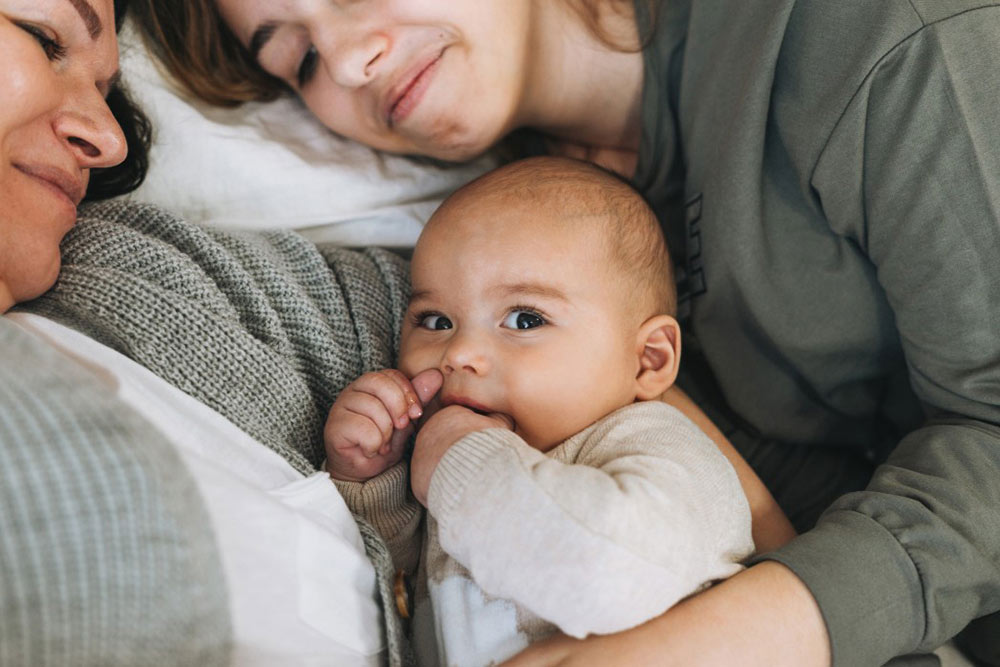Tips for Finding LGBTQ+ Friendly Childcare

Access to safe, inclusive, and supportive care for your family is possible, but it may require some strategy.
Expert Source: Nicolette Graf
Putting your child in the hands of someone else’s care is always a bit nerve-wracking. From essential responsibilities for your little one, such as feeding, diapering, and maintaining a safe environment, to emotional development and helping build their self-esteem as they grow, there’s a good deal of trust given to a chosen care provider.
Finding the right caregiver or childcare facility is difficult for any family as America’s childcare system is in crisis mode. We understand that it’s already difficult enough to find care for young children when there are nationwide teacher shortages, daycare closures, long waitlists, and exorbitant and unsustainable costs. But for LGBTQ+ parents, connecting with caregivers that foster inclusivity and use their influence for allyship can be even more difficult, and especially important, for their family’s well-being.
“[LGBTQ-inclusive childcare] is important because parents and children deserve to have access to a high-quality childcare program that reflects, represents, and respects them,” explains Nicolette Graf, equity and advocacy coordinator at Parent Aware, a voluntary quality rating and improvement system (QRIS) for childcare and early learning providers in Minnesota. “Children thrive and prosper when they can be their full, authentic selves in any learning setting, and parents can trust educators when they know inclusivity is at the core of a program.”
All parents want their kids’ care facility to be a place of safety, comfort, acceptance, and support for their children, but finding an environment that is both rid of social stigma and inclusive of all families may require some investigative work. Before beginning your search for the right childcare facility, enlist the help of this guide.
Pen Your Preferences
When it comes to making any important decision, knowing your ideal scenario beforehand helps in hatching a plan. Start by collaborating with your partner to draft a list of your nonnegotiables and agree upon what matters to you most as parents: Aside from the basics of tuition costs, proximity to home or work, hours of operation, and availability, decide if you want to see varied sexual orientations represented in the staff (gay, transgender, bisexual, etc.). Does the type of curriculum used (if in a classroom setting) matter to you or your partner? Do you want an individual or a facility that participates in advocacy and allyship and invites students and their loved ones to join? (For example, do they give to organizations like the Family Acceptance Project or participate in Pride month?)
Answering these questions will help focus your search and hopefully save you time. And while cost and proximity are certainly major factors, you may find that a friendlier option that’s more expensive or farther from home is ultimately the best choice for your family. In addition, take into consideration your child’s age and how long they will be under the supervision of the facility or care provider, as these details may factor into what’s a necessity and what’s a preference.
Prep for the Interview Process
Whether you’re looking for an in-home caregiver or an outside childcare center, you’ll need to put on your hiring hat and conduct interviews to find the best match for your family.
You can get a sense of whether or not you have shared goals and values by checking out a prospect’s website or professional page for upfront mentions of inclusivity. A friendly caregiver or facility with an inclusive environment will have thought about the introductory process as a whole and will likely make it clear along the way that they are welcoming of all families and any questions you may have as well.
Pro tip: Connect with your local Facebook group for LGBTQ+ families for recommendations of inclusive childcare centers that have provided positive experiences for the community. The word-of-mouth method is a great place to start finding trustworthy care.
Graf recommends observing the following during your initial search:
- A website or profile that uses inclusive language that’s non-assuming; This should also be reflected in the admission paperwork with appropriate options for children and adults (ex: parent/guardian vs. mother/father)
- An inclusive nondiscrimination statement that can be found on the website as well as within written materials
- Visual signs that indicate friendliness, such as rainbow posters or artwork showing diverse family structures
- Toys that are treated as non-gendered and dolls and dress-up materials that reflect a range of family types and gender expression
- An inclusive library of books depicting diverse family structures (sometimes referred to as the “windows and mirrors approach,” where students can see themselves represented as well as see others’ experiences to learn from)
Additional things to note include:
- A calendar of events that includes a vast range of holidays, celebrations, important days of recognition, and inclusive parent/student opportunities (such as a pizza party with parents vs. doughnuts with dad)
- An announcement of preferred pronouns and a request to know yours as well (could also be in the form of staff wearing pronoun stickers as a way to invite others to specify if desired)
Once you find a contender(s), set up a time to discuss your questions and take notice of their willingness to be open to your thoughts and concerns as a parent—and don’t be shy!
“Ask as many questions as possible,” says Graf. “Remember, it may be the first time that this program has been asked these questions. That doesn’t mean they wouldn’t be willing to implement changes for your family to be included. Be open-minded if they are.”
Graf also encourages parents to remember that through these sometimes challenging conversations, positive change is being created.
“As an LGBTQ parent myself, I want every family to know that they have complete control over this [childcare] decision. You are your child’s and family’s advocate, and you can ask for what you need. When looking for childcare, my wife and I had to be pretty vulnerable in asking questions like, ‘do you support families like ours?’ or ‘will our kids be included here?’ Almost every time we were met with understanding, or programs wanting to learn or make changes if they didn’t have something in place already. Inclusivity will take a village, and you have an extremely important part in that.”
Parent Aware gives the following question examples to include in your interviews:
Do you have any experience caring for children from families similar to ours?
- Do your toys and books reflect a range of families, including LGBTQ+ families?
- How would you handle questions from other children directed to my child about his/her/their family?
- How do you model and teach about gender roles?
- Do you have LGBTQ+ staff or staff who are familiar with the LGBTQ+ community?
- Do staff receive anti-bias training regularly? Do you use an anti-bias curriculum?
- Do you have a formal anti-discrimination policy in place?
- Are you open to learning more?
Additionally, don’t be afraid to ask about how staff handle conversations around issues that are relevant to diverse family structures, sexual orientation, and gender identity. It’s also worth inquiring how mean words or actions between students are resolved and what action is taken to help mediate when necessary. There’s no limit to ensuring your child’s well-being and caring for their developing self-esteem, so ask the hard questions to get the answers you need.
Other Helpful Resources
If you need further information, these organizations offer wellness and family support:
- Gay Parent Magazine’s toolkit lists friendly infant classes, preschools, and private and boarding schools by area.
- The Human Rights Campaign Foundation’s Welcoming Schools site offers teacher-friendly resources designed to help create a sense of belonging for families in classrooms. It’s an excellent resource for more ideas on what to look for in your child’s care facility.
Finding childcare isn’t always an easy task (and sometimes it feels more like searching for a needle in a haystack). Still, with the right resources, we hope quality care that’s representative and respectful can become more accessible to LGBTQ+ families—because every parent wants to know their child is in good hands.








